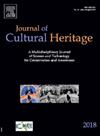XMapsLab: A program for the creation and study of maps for Cultural Heritage
IF 3.5
2区 综合性期刊
0 ARCHAEOLOGY
引用次数: 0
Abstract
The creation of maps through the application of techniques such as X-Ray Fluorescence (XRF), X-Ray Diffraction (XRD), Raman spectroscopy, multispectral analysis, ultraviolet (UV), and infrared (IR) radiation has become critical in the domain of Cultural Heritage for the analysis of materials. Limitations in data acquisition, particularly with more cost-effective and accessible devices, often restrict measurements to a sparse number of locations. This necessitates the employment of interpolation methods to extrapolate values for the unmeasured positions within the image. This paper introduces XMapsLab a software solution designed to facilitate the generation and examination of maps. XMapsLab utilizes GPU-optimized versions of interpolation methods, achieving speed enhancements ranging from one to two orders of magnitude. Such improvements markedly expand the capabilities of professionals to engage with and analyze data in real-time. Additionally, the software incorporates various interpolation methods, enhancing the robustness of the results and bolstering the confidence of experts in their conclusions. The real-time functionality of XMapsLab enables the development of new procedures for exploring hypotheses regarding the presence and distribution of pigments. This includes the integration of boolean and numerical operations for map combination, allowing users to investigate hypotheses and conditions in a direct, potent, and intuitive manner. The software developed is freely available and open-source, underscoring our commitment to supporting the broader Cultural Heritage community.
XMapsLab:一个为文化遗产创建和研究地图的程序
通过应用x射线荧光(XRF)、x射线衍射(XRD)、拉曼光谱、多光谱分析、紫外线(UV)和红外(IR)辐射等技术来创建地图,已经成为文化遗产领域分析材料的关键。数据采集方面的限制,特别是成本效益更高和更容易获得的设备,往往将测量限制在少数几个地点。这就需要使用插值方法来外推图像中未测量位置的值。本文介绍了XMapsLab这个软件解决方案,它的设计是为了方便地图的生成和检查。XMapsLab利用gpu优化版本的插值方法,实现了从一到两个数量级的速度增强。这些改进显著地扩展了专业人员实时处理和分析数据的能力。此外,该软件结合了各种插值方法,增强了结果的稳健性,增强了专家对其结论的信心。XMapsLab的实时功能允许开发新的程序来探索关于色素存在和分布的假设。这包括布尔和数值运算的集成,用于地图组合,允许用户以直接,有效和直观的方式调查假设和条件。开发的软件是免费的和开源的,强调了我们对支持更广泛的文化遗产社区的承诺。
本文章由计算机程序翻译,如有差异,请以英文原文为准。
求助全文
约1分钟内获得全文
求助全文
来源期刊

Journal of Cultural Heritage
综合性期刊-材料科学:综合
CiteScore
6.80
自引率
9.70%
发文量
166
审稿时长
52 days
期刊介绍:
The Journal of Cultural Heritage publishes original papers which comprise previously unpublished data and present innovative methods concerning all aspects of science and technology of cultural heritage as well as interpretation and theoretical issues related to preservation.
 求助内容:
求助内容: 应助结果提醒方式:
应助结果提醒方式:


